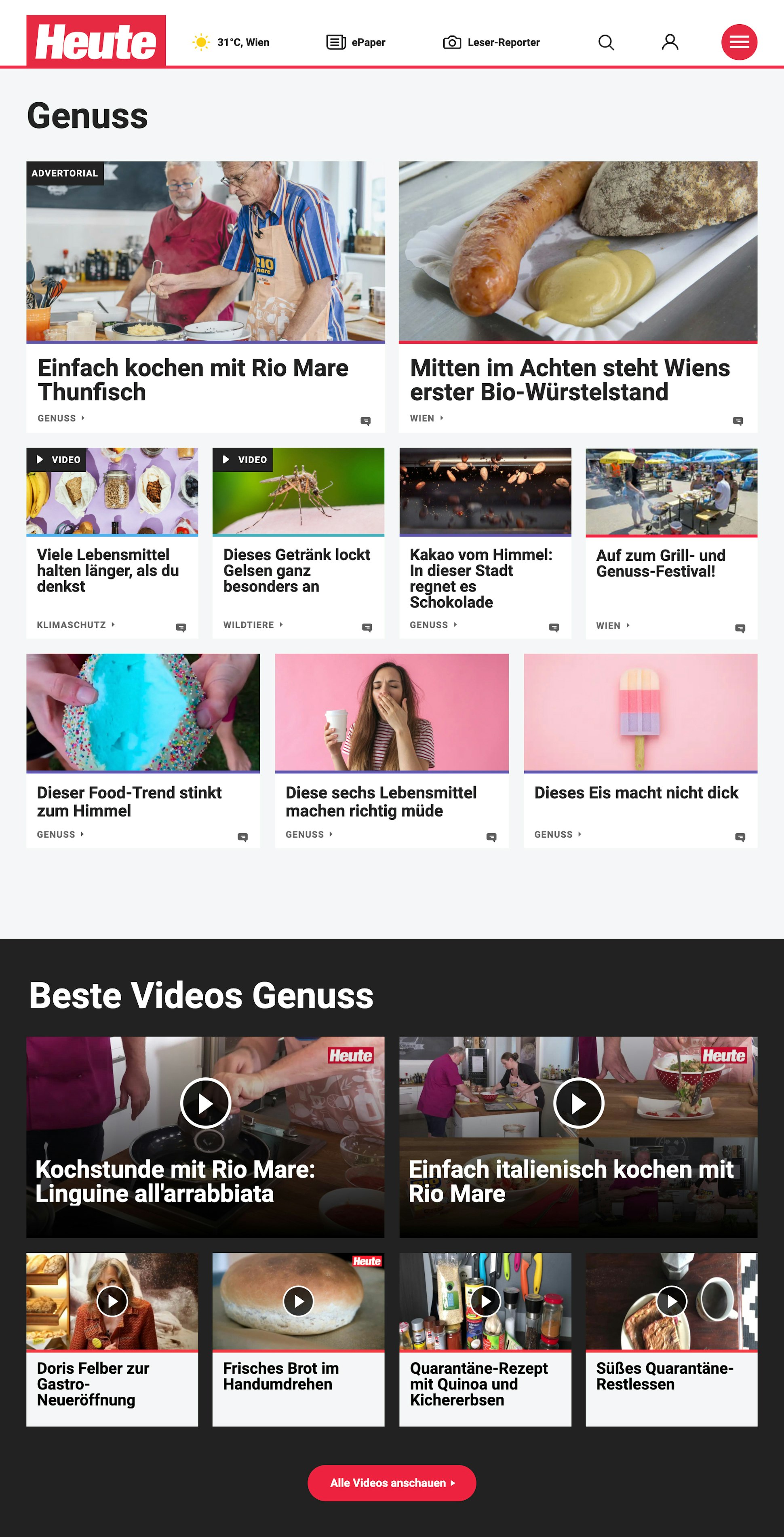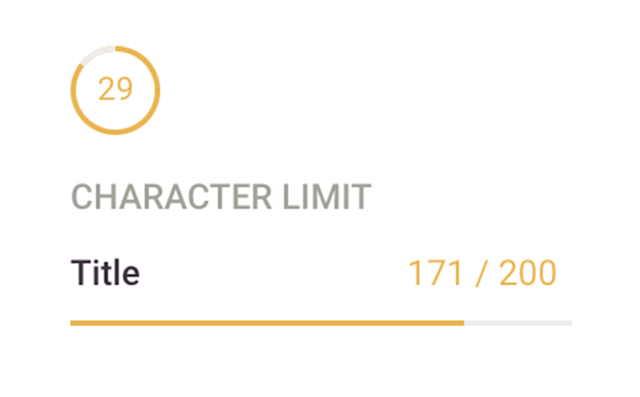Heute
The subtly quiet but powerful transition to Livingdocs
«Heute» is Austria's leading and most-read free newspaper. Furthermore it has the second-highest number of readers of all newspapers in Austria. The Swiss TX Group holds a majority interest in the online portal «Heute.at». In May 2020 alone, more than 8 million unique clients were recorded on the entire «Heute.at» offering. The visitor frequency is accordingly high and requires systems that can deliver top performance in every respect.
Goals
-
Complete replacement of the «old» CMS
-
Keep the existing front end as is, retain its design
-
User-friendly and intuitive editor for authors
-
Higher pace in news production
-
Flexibility in one's own «customisation» and further development of the system (also together with Livingdocs)
Results
-
Successful transition to Livingdocs
-
Less than 12 months from first customer contact to going live
-
Successful retention of the front end thanks to Headless CMS
-
High level of user satisfaction
-
Despite difficult circumstances (Corona crisis) a remarkable transition had been carried out online
New requirements – new system
Since 2017, «Heute.at» had been working with a CMS that was used by the Swiss majority owner of the digital section of «Heute». With a rather high degree of complexity and a large range of functions, this system fulfilled the general needs of a modern online editorial office very well. Nonetheless, certain new individual desires arose, e.g. to be able to respond more quickly and independently to new requirements in daily business and to be able to structure development more flexibly in the long term.
Considering various budget aspects a concept and a system had to be found for the transition to a new editorial system that would keep costs and workload as low as possible while still meeting the highest demands. A quiet but powerful transition needed to take place, in which readers would not notice anything at first glance, but would definitely also benefit from the system optimisation, e.g. through faster news production and new storytelling elements.
The frontend was to remain largely unaffected by the conversion of the system behind it. This reduced the complexity of the undertaking in some areas and was intended to minimise any losses in the SEO area, however brought with it very specific challenges of its own – after all, figuratively speaking, the engine of a car had to be replaced here at full speed. A project that was literally made for Livingdocs.
Livingdocs – the ideal «headless»-system
When media companies replace their publishing infrastructure, they usually redesign the appearance of their online portals at the same time. However, this is not always necessary and can sometimes even be counterproductive at the time. Many CMS are linked to the «frontend» (website) where its content is delivered. As a «headless» CMS, however, Livingdocs has no preference regarding the frontend that consumes its content. It can basically serve any kind of frontend, which can be based on every technology available. Of course, it still remained an interesting challenge to develop the perfect solution for «Heute.at», which would perfectly replace the old platform without changing the existing frontend visually or technically in any way. One of the important approaches was, for example, to install a separate interface for the existing frontend on the Livingdocs server, which then allowed a smoother transition of the systems behind it.

The modular structure of Livingdocs allows our in-house team to freely create components on overview pages and within articles and to adequately respond to the feedback of the editorial team.

Clemens Pilz,
Head of Digital Development Heute.at
Wide scope for customisation
«Heute.at» was in need of a system that was as flexible and open as possible and could be tailored to the specific needs of the editorial team. The development department should have the possibility to continue developing the CMS after the transition without losing connection and support for the core product.
Clemens Pilz, Head of Digital Development at «Heute.at» is satisfied: «The modular structure of Livingdocs allows our in-house team to freely create components on overview pages and within articles and to adequately respond to the feedback of the editorial team.» This principle also ensured the smooth integration of external components such as video players, survey tools and visualisations, which are essential for contemporary journalistic storytelling. Special emphasis was placed on intuitive application – long-standing print journalists should be able to use the system in the same way as young «digital natives». Instead of blocking the entry into advanced online work like a barrier, this new CMS was to invite and animate all users to do so through a clear structure and a wide variety of design options.
«In working with the ‹Heute› team, Livingdocs demonstrated a high degree of flexibility and cooperativeness to improvise» says Clemens Pilz. In order to accommodate the work processes of the editorial team, several features were added to the core product, including new upload options for photos, more extensive search functions, a character limit for the article title and the placement of stories on overview pages with special tags.
The «Heute» editorial team works convergently – that means: employees research their stories and then write both print and online articles. In print newspaper production, pages are designed together with the layout, which are then filled directly in Adobe InDesign and sent to the printing press as PDFs at the end of the day. In Livingdocs, the editors prepare their stories for «Heute.at», enrich them with multimedia elements and, after publication by the editor-in-chief, deliver them via digital distribution channels.
One of the new requested functions is the character restriction, which counts, displays and limits the number of characters entered per component to a set maximum.

Acceptance in the editorial department
The editors' feedback during training and in the first weeks after the transition was consistently positive. Especially the clear structure of the system on the article level and the intuitive writing and creating of central elements were highly praised. Due to the Corona pandemic and the resulting home office work mode for large parts of the editorial team, adjustments in the workflow were definitely a challenge, but already after a few days everything and everyone got up to speed well: The proofreading function in Livingdocs allows different workflow approaches to publishing stories, depending on the corresponding situation. As a rule, an editor can forward his finished article to his head of department, who edits the story and sends it to the editor-in-chief for publication. If necessary, however, an employee can also forward the story directly to the heads of the editorial office – or in the case of breaking news, if he or she has been given permission to do so, put the story online directly and place it in the frontend.
The Corona Crisis put it all to the test
The transition to Livingdocs had been carefully planned a long time ahead and then suddenly the Corona crisis hit the «Heute» team during its «hottest» phase. Not only could the communication with Livingdocs only be done via chats, telephone calls and video conferences in the final weeks due to the pandemic – the borders between Austria and Switzerland were fully shut – also internally at «Heute» entirely new ways of interaction and communication had to be found.
«Originally, all employees were to be introduced to the new system in extensive, personal training sessions. But because of the danger of getting infected with the coronavirus, this was no longer an option» says Clemens Pilz. In order to be able to stick to the planned schedule despite the crisis, detailed training material with video tutorials, manuals and online hangouts were produced for the editorial team. «The fact that the transition to the new CMS was yet successful under these adverse circumstances is due to our team's willingness to improvise as well as the personal commitment of our editors, who familiarised themselves with Livingdocs in their home office.»
In cooperation with the Livingdocs team, we have succeeded in developing a product that meets the highest technical standards.

Clemens Oistric,
Editor-in-chief Heute.at
«Heute» is ready for tomorrow
The successful conversion of «Heute.at» is excellent proof that the comprehensive and inspiring publishing experience of Livingdocs can be integrated and implemented everywhere and even under difficult external conditions – even «behind» an existing portal that has not specifically been improved for its readers, but primarily for its editors and developers. «Heute.at» editor-in-chief Clemens Oistric is delighted: «In cooperation with the Livingdocs team, we have succeeded in developing a product that meets the highest technical standards. The intuitive application and the modular structure guarantee speed and flexibility in our daily news production.»
By having changed to the new system, the «Heute» development team can in future respond directly and quickly to the wishes of the editorial staff and further develop the CMS parallel to ongoing operations and tailor it to the current production situation. First projects were already formulated only a few weeks after the launch. In the medium term, not only comfort features are planned, but also new possibilities in «storytelling». Frontend and backend will be further processed together in order to give editors the freedom to visualise their journalistic content.